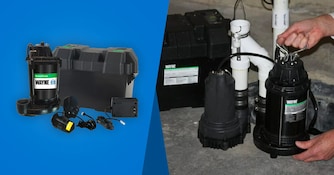
Sump Pump Battery Buyer's Guide
Whether you like to be prepared or are someone who has had to clean up a flooded basement, you understand that an ounce of prevention is worth a pound of cure.
In a power outage, sump pumps
are useless without a backup power source like a sump pump battery. But, with so many types of batteries on the market (and almost none labeled for sump pumps), how do you choose the right one?
You could, of course, skip the hassle and purchase a backup sump pump that comes with the battery, but in case you haven't or need a replacement-read on.
What Terms Are Used to Describe Batteries?

When you're shopping for a backup battery for your sump pump, you'll notice terms being used like "deep-cycle," "maintenance-free," "marine," and "solar." But since they're used interchangeably to describe standby lead-acid batteries, buying the right one can be confusing. Now, we'll decode the battery nomenclature that will help you differentiate one battery from the next, so you can find the perfect type of battery for your sump pump.
Deep-Cycle Batteries
The deep-cycle designation itself does
not
indicate the
type
of battery, but rather the battery's
charging cycle, and is an important term to know when looking for a sump pump battery.
These batteries are made for constant charging and discharging, ("cycling") without rapidly degrading the integrity of the battery. Although they cannot deliver the higher current of a wet-cell battery, they feature thicker plates and are able to be discharged to a much greater degree. A compromise between these characteristics (higher starting/lower discharging capacity) is often "Marine/RV" type batteries.
Maintenance-Free Batteries
The term "maintenance-free" can be misleading depending on the battery type. For wet-cell types, maintenance-free means these batteries are sealed and are sometimes valve-regulated (VRLA) in which the hydrogen and oxygen produced by the cells are reconstituted back into the water, thereby reducing leakage and rapid evaporation. Even though they're called "maintenance-free", it really is a misnomer because they still require maintenance to prevent the cells from drying out and losing their capacity to cycle.
Types of Lead-Acid Backup Batteries
1. Wet Cell Batteries

The most inexpensive type of battery, wet-cell or "flooded" types are most commonly found in automotive applications. They do a great job in short bursts to start your car, but you wouldn't want them to power your sump pump for an extended period; that's why they're often called "starting batteries". The only exception is a deep-cycle version.
Made up of acid-covered lead plates submerged in an electrolyte liquid, wet-cell batteries come in both sealed and unsealed versions. Regardless of the version, both require periodic inspection to keep the lead cells from drying out to prevent damage. Maintaining these batteries is a dangerous task as you'll be exposed to lead, acid, noxious gas, and the risk of explosion.
2. AGM Batteries
 AGM stands for Absorbed Glass Mat and is a technologically superior battery, perfect for backup sump pump systems. AGM batteries feature a unique design that encapsulates the lead-acid cells in glass fiber material that absorbs electrolytes (only enough to keep it wet rather than being completely submerged) and won't leak if punctured, making them relatively safe to use. The design also allows for the cells to be stacked closer together allowing for increased energy capacity and faster charging times.
AGM stands for Absorbed Glass Mat and is a technologically superior battery, perfect for backup sump pump systems. AGM batteries feature a unique design that encapsulates the lead-acid cells in glass fiber material that absorbs electrolytes (only enough to keep it wet rather than being completely submerged) and won't leak if punctured, making them relatively safe to use. The design also allows for the cells to be stacked closer together allowing for increased energy capacity and faster charging times.
AGM batteries are considered truly "maintenance free", meaning you don't have to worry about the cells drying out and trying to add water yourself. They do tend to be more expensive, but the many safety and performance features far outweigh the cost.
3. Gel Batteries
A gel battery is similar to a wet-cell battery, except it is filled with a gelled electrolyte using silica gel. The small packets that come in vitamin bottles contain the same type of material used in gel batteries. Also considered "maintenance-free", the gel will not evaporate, making gel batteries ideal in tougher situations where there are extreme temperatures and vibrations.
This is why they're most often found in racing and off-road vehicles, as well as wind and solar applications. However, since the gel design prevents rapid movement, ion exchange and peak current capacity are also reduced along with fast-charging times.
How to Check Your Backup Battery
Even "maintenance-free" batteries need to be looked at once in a while to make sure they will perform as they should. But,
how to do you check a sealed battery? The easiest way is to see if the battery has a sight glass that will indicate low electrolyte levels. The other way is to check the battery's performance using a multi-meter.
*Pro Tip: Regardless of type, you should never place or store a battery directly on the ground. Doing so will drain the battery and shorten its life. Instead, you could use a battery case, keep it at least 3-4 feet off the ground, and make a habit to check and clean your battery terminals per the manufacturer's recommendation every 3 months.
Ready for the Unexpected

Now that you know how to pick the perfect battery for your sump pump and know when and how to get a replacement, you won't have to worry about it failing when you need it most.
If you have questions about specific sump pumps and batteries, the experts here at Sump Pumps Direct are ready to answer.
![]() NEXT: Backup Sump Pump Buyer's Guide
NEXT: Backup Sump Pump Buyer's Guide





